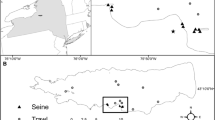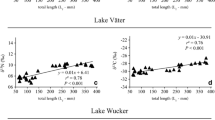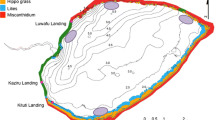Abstract
Since the introduction of white perch (Morone americana) into Lake Erie over 50 years ago, the population size of native yellow perch (Perca flavescens) has decreased up to 79 % and significant changes to the ecosystem have occurred. We examined long-term population estimates and used stable isotopes of carbon (δ 13C) and nitrogen (δ 15N) paired with stomach content analysis to quantify the trophic ecology and niche overlap of adult yellow perch and white perch in the western basin of Lake Erie. We found that changes in yellow perch abundance since 1979 appeared to be better correlated with changes in fishery exploitation rates than with food competition effects from white perch. At the time of this study, yellow perch were found to have higher δ 13C values, indicating greater utilization of benthic food resources than white perch, and white perch occupied higher trophic positions based on δ 15N. The diets of both species varied spatially and seasonally based on stable isotopes and stomach contents, likely driven by changes in prey abundance. Comparison of niche widths using stable isotope population metrics and Schoener diet similarity index suggested a low to moderate degree of niche overlap between species. Isotopic niches of white perch were generally larger than those of yellow perch demonstrating broader resource utilization by this non-indigenous species. We submit that isotopic niche overlap comparisons are more appropriate for studies seeking to understand interactions among populations over course temporal scales, while diet overlap indices, such as the Schoener index provide a means to study fine-scale interactions such as ontogenetic and seasonal diet shifts.





Similar content being viewed by others

References
Baker DB, Richards RP (2002) Phosphorus budgets and riverine phosphorus export in northwestern Ohio watersheds. J Environ Qual 31:96–108
Barbiero RP, Tuchman ML (2001) Results from the US EPA’s biological open water surveillance program of the Laurentian Great Lakes: I. Introduction and phytoplankton results. J Great Lakes Res 27:134–154
Barbiero RP, Little RE, Tuchman ML (2001) Results from the US EPA’s biological open water surveillance program of the Laurentian Great Lakes: III. Crustacean zooplankton. J Great Lakes Res 27:167–184
Bearhop S, Waldron S, Votier SC, Furness RW (2002) Factors that influence assimilation rates and fractionation of nitrogen an carbon stable isotopes in avian blood and feathers. Physiol Biochem Zool 75:451–458
Bearhop S, Adams CE, Waldron S, Fuller RA, Macleod H (2004) Determining trophic niche width: a novel approach using stable isotope analysis. J Anim Ecol 73:1007–1012
Bohn T, Amundsen PA (2001) The competitive edge of an invading specialist. Ecology 82:2150–2163
Boileau MG (1985) The expansion of white perch, Morone americana, in the lower Great Lakes. Fisheries 10:6–10
Bruno JF, Cardinale BJ (2008) Cascading effects of predator richness. Front Ecol Environ 6:539–546
Busch WN, Davies DH, Nepszy SJ (1977) Establishment of white perch, Morone americana, in Lake Erie. J Fish Res Board Can 34:1039–1041
Caut S, Angulo E, Courchamp F (2009) Variation in discrimination factors (δ 13C and δ 15N): the effect of diet isotope values and applications for diet reconstruction. J Appl Ecol 46:443–453
Christie WJ (1972) Lake Ontario—effects of exploitation, introductions, and eutrophication on salmonid community. J Fish Res Board Can 29:913–929
Cohen AN, Carlton JT (1998) Accelerating invasion rate in a highly invaded estuary. Science 279:555–558
Couture SC, Watzin MC (2008) Diet of invasive adult white perch (Morone americana) and their effects on the zooplankton community in Missisquoi Bay, Lake Champlain. J Great Lakes Res 34:485–494
DeNiro MJ, Epstein S (1981) Influence of diet on the distribution of nitrogen isotopes in animals. Geochim Cosmochim Acta 45:341–351
Dennis CA, MacNeil MA, Rosati JY, Pitcher TE, Fisk AT (2010) Diet discrimination factors are inversely related to δ 13C and δ 15N values of food for fish under controlled conditions. Rapid Commun Mass Sp 24:3515–3520
DFO (2006) Canadian fisheries statistics, 2005. Fisheries and Oceans Canada, Ottawa
Ditoro DM, Thomas NA, Herdendorf CE, Winfield RP, Connolly JP (1987) A post audit of a lake eutrophication model. J Great Lakes Res 13:801–825
Dolan DM, Mcgunagle KP (2005) Lake Erie total phosphorus loading analysis and update: 1996–2002. J Great Lakes Res 31:11–22
Duncan JM, Marschner CA, Gonzalez MJ (2011) Diet partitioning, habitat preference and behavioral interactions between juvenile yellow perch and Round Goby in nearshore areas of Lake Erie. J Great Lakes Res 37:101–110
Forage Task Group (2010) Report of the Lake Erie forage task group. Presented to the Standing Technical Committee, Lake Erie Committee of the Great Lakes Fishery Commission, Ann Arbor
Freeman M, Dietz P, Kayle K, Kenyon R, Knight C, Thomas M (1996) Report of the Lake Erie yellow perch task group. Great Lakes Fishery Commission, Ann Arbor
Garton DW, Payne CD, Montoya JP (2005) Flexible diet and trophic position of dreissenid mussels as inferred from stable isotopes of carbon and nitrogen. Can J Fish Aquat Sci 62:1119–1129
Gopalan G, Culver DA, Lin W, Trauben BK (1998) Effects of recent ecosystem changes on the recruitment of young of the year fish in western Lake Erie. Can J Fish Aquat Sci 55:2572–2579
Great Lakes Fishery Commission (1995) Fish community objectives for Lake Huron. Great Lakes Fishery Commission, Ann Arbor
Great Lakes Fishery Commission (2007a) Strategy and options for promoting the rehabilitation of ciscoes in Lake Huron. Great Lakes Fishery Commission, Ann Arbor
Great Lakes Fishery Commission (2007b) Environmental objectives for Lake Huron. Great Lakes Fishery Commission, Ann Arbor
Guzzo MM, Haffner GD, Sorge S, Rush SA, Fisk AT (2011) Spatial and temporal variability of δ13C and δ15N within lower trophic levels of a large lake: implications for estimating trophic relationships of consumers. Hydrobiologia 675:41–53
Hammerschlag-Peyer C, Yeager LA, Araujo MS, Layman CA (2011) A hypothesis-testing framework for studies investigating ontogenetic niche shift using stable isotope ratios. PLOS One. doi:10.1371/journal.pone.0027104
Hayward RS (1988) Eutrophication effects on bioenergetic conditions for Lake Erie yellow perch. Ph. D. Thesis, The Ohio State University
Hayward RS, Margraf FJ (1987) Eutrophication effects on prey size and food available to yellow perch in Lake Erie Trans. Am Fish Soc 116:210–223
Holeck KT, Mills EL, Macisaac HJ, Dochoda MR, Colautti RI, Ricciardi A (2004) Bridging troubled waters: biological invasions, transoceanic shipping, and the Laurentian Great Lakes. Bioscience 54:919–929
Jackson AL, Inger R, Parnell AC, Bearhop S (2011) Comparing isotopic niche widths among and within communities: SIBER—Stable Isotope Bayesian Ellipses in R. J Anim Ecol 80:595–602
Jackson MC, Donohue I, Jackson AL, Britton JR, Harper DM, Grey J (2012) Population-level metrics of trophic structure based on stable isotopes and their application to invasion ecology. PLoS One 7(2):e31757. doi:10.1371/journal.pone.0031757
Johnson BM, Martinez PJ, Stockwell JD (2002) Tracking trophic interactions in coldwater reservoirs using naturally occurring stable isotopes. Trans Am Fish Soc 131:1–13
Kane DD, Gordon SI, Munawar M, Charlton MN, Culver DA (2009) The Planktonic Index of Biotic Integrity (P-IBI): an approach for assessing lake ecosystem health. Ecol Indic 9:1234–1247
Larsen A (1954) First record of the white perch (Morone americana) in Lake Erie. Copeia 1954:154
Layman CA, Allgeier JE (2012) Characterizing trophic ecology of generalist consumers: a case study of the invasive lionfish in The Bahamas. Mar Ecol Prog Ser 448:131–141
Layman CA, Arrington DA, Montana CG, Post DM (2007) Can stable isotope ratios provide for community-wide measures of trophic structure? Ecology 88:42–48
Legler ND (2008) Effects of Lake Erie habitat variation and digestion rate on feeding in freshwater fishes. M.Sc. Thesis, University of Windsor
Levine JM, D’antonio CM (2003) Forecasting biological invasions with increasing international trade. Conserv Biol 17:322–326
Lodge DM (1993) Biological invasions: lessons for ecology. Trends Ecol Evol 8:133–137
Mack RN, Lonsdale WM (2001) Humans as global plant dispersers: getting more than we bargained for. Bioscience 51:95–102
Mack RN, Simberloff D, Lonsdale WM, Evans H, Clout M, Bazzaz FA (2000) Biotic invasions: causes, epidemiology, global consequences, and control. Ecol Appl 10:689–710
Martinez del Rio C, Wolf N, Carleton SA, Gannes LZ (2009) Isotopic ecology ten years after a call for more laboratory experiments. Biol Rev Camb Philos Soc 84:91–111
Marvier M, Kareiva P, Neubert MG (2004) Habitat destruction, fragmentation, and disturbance promote invasion by habitat generalists in a multispecies metapopulation. Risk Anal 24:869–878
Mathur D (1977) Food habits and competitive relationships of the bandfish shiner in Halawakee Creek, Alabama. Am Midl Nat 97:89–100
McKinney ML, Lockwood JL (1999) Biotic homogenization: a few winners replacing many losers in the next mass extinction. Trends Ecol Evol 14:450–453
Mills EL, Leach JH, Carlton JT, Secor CL (1994) Exotic species and the integrity of the Great Lakes- lessons from the past. Bioscience 44:666–676
Moyle PB, Light T (1996) Biological invasions of fresh water: empirical rules and assembly theory. Biol Cons 78:149–162
Olden JD, Poff NL, Douglas MR, Douglas ME, Fausch KD (2004) Ecological and evolutionary consequences of biotic homogenization. Trends Ecol Evol 19:18–24
Ontario Ministry of Natural Resources (2012) 2011 Status of major stocks. Lake Erie Management Unit, ISSN 1718-4924 (Print), ISBN 978-1-4435-8983-3 (Print, 2011 ed.), ISSN 1925-5454 (Online), ISBN 978-1-4435-8984-0 (PDF, 2011 ed.). 79 pp
Parrish DL (1988) The white perch and its interactions with yellow perch in Lake Erie. Ph. D. Thesis The Ohio State University
Parrish DL, Margraf FJ (1990) Interactions between white perch (Morone americana) and yellow perch (Perca flavescens) in Lake Erie as determined from feeding and growth. Can J Fish Aquat Sci 47:1779–1787
Parrish DL, Margraf FL (1991) Prey selectivity by age-0 white perch (Morone americana) and yellow perch (Perca flavescens) in laboratory experiments. Can J Fish Aquat Sci 48:607–610
Parrish DL, Margraf FJ (1994) Spatial and temporal patterns of food use by white perch and yellow perch in Lake Erie. J Freshwater Ecol 9:29–35
Perga ME, Gerdeaux D (2005) Are fish what they eat’ all year round? Oecologia 144:598–606
Peterson BJ, Fry B (1987) Stable isotopes in ecosystem studies. Annu Rev Ecol Syst 18:293–320
Polo-Cavia N, Lopez P, Martin J (2008) Interspecific differences in responses to predation risk may confer competitive advantages to invasive freshwater turtle species. Ethology 114:115–123
Post DM (2002) Using stable isotopes to estimate trophic position: models, methods, and assumptions. Ecology 83:703–718
Power M, Guiguer KRRA, Barton DR (2003) Effects of temperature on isotopic enrichment in Daphnia magna: implications for aquatic food web studies. Rapid Commun Mass Sp 17:1619–1625
R Development Core Team (2012) R: a language and environment for statistical computing. R Foundation for Statistical Computing, Vienna
Reichert JM, Fryer BJ, Pangle KL, Johnson TB, Tyson JT, Drelich AB, Ludsin SA (2010) River-plume use during the pelagic larval stage benefits recruitment of a lentic fish. Can J Fish Aquat Sci 67:987–1004
Ricciardi A (2006) Patterns of invasion in the Laurentian Great Lakes in relation to changes in vector activity. Divers and Distrib 12:425–433
Ricciardi A, MacIsaac HJ (2000) Recent mass invasion of the North American Great Lakes by Ponto-Caspian species. Trends Ecol Evol 15:62–65
Roseman EF, Taylor WW, Hayes DB, Hanes AL, Francis JT (2006) Predation on walleye eggs by fish on reefs in Western Lake Erie. J Great Lakes Res 32:415–423
Ruiz GM, Fofonoff PW, Carlton JT, Wonham MJ, Hines AH (2000) Invasion of coastal marine communities in North America: apparent patterns, processes, and biases. Annu Rev Eco Syst 31:481–531
Sakai AK, Allendorf FW, Holt JS, Lodge DM, Molofsky J, With KA, Baughman S, Cabin RJ, Cohen JE, Ellstrand NC, McCauley DE, O’Neil P, Parker IM, Thompson JN, Weller SG (2001) The population biology of invasive species. Annu Rev Eco Syst 32:305–332
Sax DF, Brown JH (2000) The paradox of invasion. Global Eco Biogeogr 9:363–371
Schaeffer JS, Margraf FJ (1986a) Food of white perch (Morone americana) and potential for competition with yellow perch (Perca flavescens) in Lake Erie. Ohio J Sci 86:26–29
Schaeffer JS, Margraf FJ (1986b) Population characteristics of the invading white perch (Morone americana) in western Lake Erie. J Great Lakes Res 12:127–131
Schoener TW (1968) The Anolis lizards of Bimini: resource partitioning in a complex fauna. Ecology 49:704–726
Scott WB, Crossman EJ (1973) Freshwater fishes of Canada. Bull Fish Res Board Can 184:966
Stanley JG, Danie DS (1983) Species profiles: life histories and environmental requirements of coastal fishes and invertebrates (North Atlantic-white perch). USFW, Division of Biological Services. FWS/OBS-82/11.7
Turner TF, Collyer ML, Krabbenhoft TJ (2010) A general hypothesis-testing framework for stable isotope ratios in ecological studies. Ecology 91:2227–2233
Tyson JT, Knight RL (2001) Response of yellow perch to changes in the benthic invertebrate community of western Lake Erie. T Am Fish Soc 130:766–782
Tyson JT, Johnson TB, Knight CT, Bur MT (2006) Intercalibration of research survey vessels on Lake Erie. N Am J Fish Manag 26:559–570
United States Geological Survey (2010) Fisheries research and monitoring activities of the Lake Erie Biological Station, 2009. Sandusky, Ohio
Vander Zanden MJ, Casselman JM, Rasmussen JB (1999) Stable isotope evidence for the food web consequences of species invasions in lakes. Nature 401:464–467
Vanderklift MA, Ponsard S (2003) Sources of variation in consumer δ 15N enrichment: a meta analysis. Oecologia 136:169–182
Vitousek PM, Dantonio CM, Loope LL, Rejmanek M, Westbrooks R (1997) Introduced species: a significant component of human-caused global change. NZ J Ecol 21:1–16
Wong RK, Noble RL, Jackson JR, VanHorn S (1999) White perch invasion of B. Everett Jordan Reservoir, North Carolina. Proc Annu Conf Southeast Assoc Fish Wildl Agencies 53:12–169
Yellow Perch Task Group (2011) Report of the Lake Erie Yellow Perch task group. Presented to the Standing Technical Committee, Lake Erie Committee of the Great Lakes Fishery Commission, Ann Arbor
Zaret TM, Rand AS (1971) Competition in tropical stream fishes: support for the competitive exclusion principle. Ecology 52:336–342
Zhao YM, Jones ML, Shuter BJ, Roseman EF (2009) A biophysical model of Lake Erie walleye (Sander vitreus) explains interannual variations in recruitment. Can J Fish Aquat Sci 66:114–125
Zuerlein G (1981) The white perch in Nebraska. Nebraska Game and Parks Commission. Tech. Ser. 8. Lincoln
Acknowledgments
The authors would like to thank Sandra Ellis, Anna Hussey, Eric Primeau, Mary-Lynn Mailloux, Carly Ziter and Kristen Diemer for their assistance in the laboratory. Craig MacDonald, Andy Cook and the staff at the Ontario Ministry of Natural Resources Lake Erie Management Unit, Vicki Lee, Jeremy Hatt, Willi Powell and many additional personnel with the Ontario Ministry of Natural Resources and National Oceanic and Atmospheric Administration, and Jeff Tyson, Eric Weimer and the staff at the Ohio Department of Natural Resources Sandusky Fish Research Unit for their help in sample collection. Richard Kraus and the staff at the USGS Lake Erie Biological Station for providing diet data. Andrew Chapelsky for his help with data processing. We would also like to thank the anonymous reviewers for their helpful insights and recommendations. This work was funded by Canada Research Chair funds awarded to A. T. Fisk and G. D. Haffner, The Great Lakes Fishery Commission, Ontario Ministry of Natural Resources, and Natural Sciences and Engineering Research Council of Canada for funding to Dan Heath and Stuart Ludsin, and graduate assistantships awarded to M.M.G. and N.D.L. from the University of Windsor.
Author information
Authors and Affiliations
Corresponding author
Rights and permissions
About this article
Cite this article
Guzzo, M.M., Haffner, G.D., Legler, N.D. et al. Fifty years later: trophic ecology and niche overlap of a native and non-indigenous fish species in the western basin of Lake Erie. Biol Invasions 15, 1695–1711 (2013). https://doi.org/10.1007/s10530-012-0401-z
Received:
Accepted:
Published:
Issue Date:
DOI: https://doi.org/10.1007/s10530-012-0401-z



